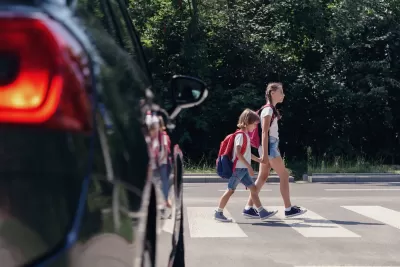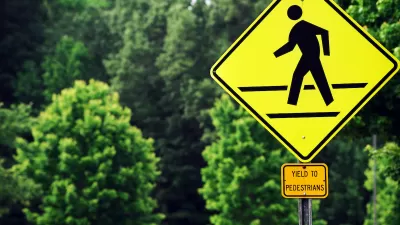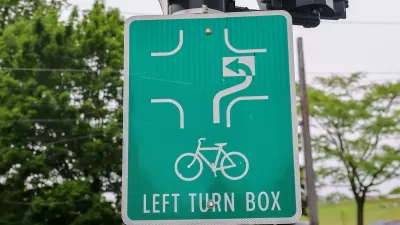The guiding document for U.S. road design is starting to recognize the needs of people walking and biking, but safe streets advocates say more significant changes are needed to reduce the high number of pedestrian deaths and improve connectivity for all road users.

A powerful federal document that dictates street design is getting a makeover after years of advocacy, reports Josh Naramore in Streetsblog USA.
The Manual on Uniform Traffic Control Devices (MUTCD), first created in 1935, governs all road markings, speed limits, road signage, and traffic signals in the United States. The document has rarely been updated, perpetuating outdated and dangerous road design practices. As Naramore explains, “The MUTCD prioritizes moving private vehicles at maximum efficiency and speed above all other goals, including safety, sustainability, and access for people walking, biking, in a wheelchair, or on a bus.”
The December 2023 update to the document signaled a major shift in priorities, focusing for the first time on the safety of pedestrians and other vulnerable road users. However, Naramore argues that it “fails to include many necessary reforms that would create comprehensively safe streets.”
While the update encourages traffic calming and mechanisms that prevent speeding, makes it easier to install crosswalks, and explicitly allows the use of painted bike and transit lanes, it falls short in some areas, such as failing to recognize that not all groups of pedestrians — such as children — can be expected to act “alertly and attentively.” Meanwhile, “To justify installing pedestrian signals, the MUTCD still requires a very high volume of people to be crossing an unprotected intersection — or that transportation officials wait for multiple traffic injuries or deaths to occur.”
Naramore also expresses concern about the MUTCD’s new language on autonomous vehicles, which “normalizes nascent driverless technology without understanding its consequences.” Naramore suggests that safe streets advocates must continue promoting changes that are more in line with the Safe System approach and truly recognize how road design impacts the safety of people inside and outside of cars.
FULL STORY: The 1,000-Page Document That Decides Your Street Designs Just Got a Refresh

Trump Administration Could Effectively End Housing Voucher Program
Federal officials are eyeing major cuts to the Section 8 program that helps millions of low-income households pay rent.

Planetizen Federal Action Tracker
A weekly monitor of how Trump’s orders and actions are impacting planners and planning in America.

Ken Jennings Launches Transit Web Series
The Jeopardy champ wants you to ride public transit.

Washington Legislature Passes Rent Increase Cap
A bill that caps rent increases at 7 percent plus inflation is headed to the governor’s desk.

From Planning to Action: How LA County Is Rethinking Climate Resilience
Chief Sustainability Officer Rita Kampalath outlines the County’s shift from planning to implementation in its climate resilience efforts, emphasizing cross-departmental coordination, updated recovery strategies, and the need for flexible funding.

New Mexico Aging Department Commits to Helping Seniors Age ‘In Place’ and ‘Autonomously’ in New Draft Plan
As New Mexico’s population of seniors continues to grow, the state’s aging department is proposing expanded initiatives to help seniors maintain their autonomy while also supporting family caregivers.
Urban Design for Planners 1: Software Tools
This six-course series explores essential urban design concepts using open source software and equips planners with the tools they need to participate fully in the urban design process.
Planning for Universal Design
Learn the tools for implementing Universal Design in planning regulations.
Heyer Gruel & Associates PA
Ada County Highway District
Institute for Housing and Urban Development Studies (IHS)
City of Grandview
Harvard GSD Executive Education
Toledo-Lucas County Plan Commissions
Salt Lake City
NYU Wagner Graduate School of Public Service





























